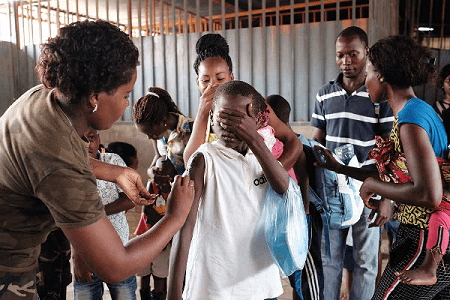Information emerging from the high-powered Regional Meeting of WHO, GAVI– the Vaccine Alliance, UNICEF, and other partners in Abuja, Nigeria, indicated that Nigerians and other Africans, from Yellow fever endemic countries, will soon be free from the grip of the Yellow fever by 2026.
The good news came up as the world health giants- WHO, GAVI– the Vaccine Alliance, UNICEF and more than 50 health partners, threw their weights behind a new campaign tagged “Eliminate Yellow fever Epidemics (EYE) in Africa”, which was newly introduced by the WHO Director General, Dr Adhanom Ghebreyesus Tedros; Minister of Health, Professor Isaac Folorunso Adewole; and partners at a regional meeting in Abuja, on Tuesday 10 April, 2018.

Speaking through a press statement sent from the conference, Dr Tedros decried the elevated risk of Yellow fever outbreak facing the world as a whole, and African communities in particular, noting that it is of great concern to world health leaders, as they have come together to strategise on how to eradicate the disease.
He said: “The world is facing an increased risk of Yellow fever outbreaks and Africa is particularly vulnerable. With one injection we can protect a person for life against this dangerous pathogen. This unprecedented commitment by countries will ensure that by 2026, Africa is free of Yellow fever epidemics.”
Dr Tedros also explained the roles of various partners in the preventive strategic campaign to end Yellow fever in Africa, stating that GAVI, the Vaccine Alliance has worked consistently to improve the quality and availability of vaccines to endemic countries, while UNICEF will join in ensuring availability of vaccines for children immunization as well as promote political support for countries with outbreaks.
According to the CEO of Gavi, the Vaccine Alliance, Dr Seth Berkley, “This comprehensive, global strategy offers an unprecedented opportunity to end the devastating Yellow fever epidemics that periodically impact Africa. Ensuring that the most vulnerable communities have access to the vaccine through routine systems plays a central role in making this happens.
Vaccine manufacturers and Gavi partners have worked hard to improve the global vaccine supply situation in recent years to make sure there is enough vaccine to respond to outbreaks, allow preventive campaigns and that routine immunization functions at full capacity.”
The document highlighted the three objectives of the strategy to include: protecting at-risk populations through preventive mass vaccination campaigns and routine immunization programmes, preventing international spread, and containing outbreaks rapidly. Developing strong surveillance with robust laboratory networks is key to these efforts.
The release disclosed that during the three-day EYE strategy regional launch meeting, which commenced in Abuja on Tuesday, to run till Thursday, representatives from key African countries, WHO, UNICEF, Gavi, and other partners will be developing a roadmap on how to roll-out the EYE strategy at national level. This implementation effort follows the endorsement of the strategy by African Ministers of Health at the 67th WHO regional committee in September 2017.
For the UNICEF’s Chief of Health, Stefan Peterson, the campaign is critical to saving children’s lives, and would go a long way toward stamping out this disease, because majority of people affected are children. “Today, the threat of Yellow fever looms larger than ever before, especially for thousands of children across Africa. Given that almost half of the people to be vaccinated are children under 15 years of age”.
The statement recalled several outbreaks of the disease in the past, and the ongoing outbreaks, with the fatality recorded from it so far.
“After outbreaks of Yellow fever in densely populated cities in Angola and the Democratic Republic of Congo caused 400 deaths in 2016, the acute viral haemorrhagic disease re-emerged as a serious global public health threat. Brazil is currently battling its worst outbreak of Yellow fever in decades with more than 1,000 confirmed cases.
However, the ease and speed of population movements, rapid urbanization and a resurgence of mosquitoes due to global warming have significantly increased the risk of Yellow fever outbreaks in urban with international spread”, it revealed.










